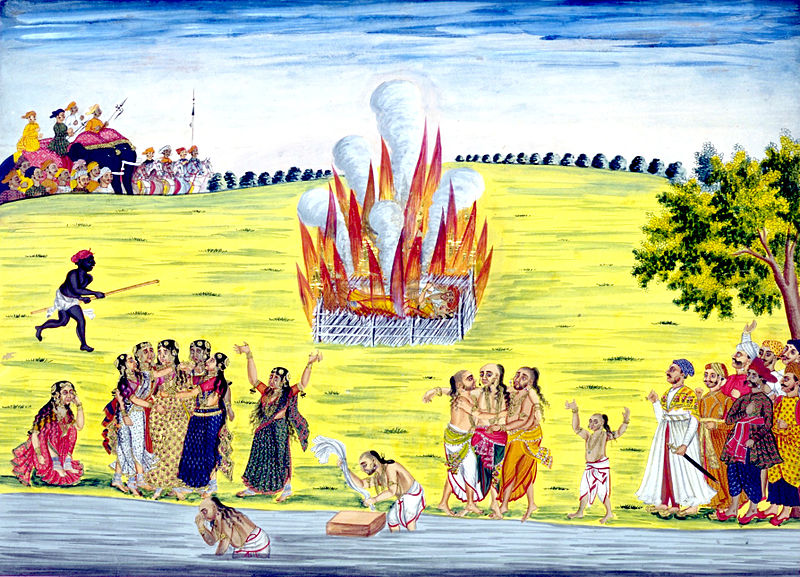Sati, also known as “Suttee,” was a tradition that was practiced in ancient India from the early centuries BCE to the mid-1990’s. In this tradition, widows were burned at the side of their deceased husbands. There were many reasons behind this tragic form of suicide, but the act was seen as heroic and courageous. The tradition originates with the goddess Sati, who burned herself to death in a fire that she created through her yogic powers, which she obtained after her father had insulted her husband. Sati became an option for women in India who were not “marriageable,” according to social norms. Sati was first recognized in the Mahabharata, one of the two most well-known and important poems of India.1
“LAMP of my life, the lips of Death
Hath blown thee out with their sudden breath;
Naught shall revive thy vanished spark . . .
Love, must I dwell in the living dark?” -Suttee by Sarojini Naidu2
The practice of Sati is recounted by a first century BCE Greek author named Diodorus Siculus. Diodorus mentioned sati stones, which were memorials of all of the wives that have passed along with their husbands. A stone was created for each wife after she gave up her life, and these stones were all collected into a shrine. The earliest memorial that has been discovered dates from 510 BCE.3

Another practice that branched out from sati was the Jahuar, which was a sacrifice of any Muslim woman from the twelfth through the sixteenth century. It was believed that if a woman was burned, she would be safe from rape, which was worse than dying at the hands of a conquering enemy.4
Sati was also practiced by the Brahmans of Bengal, by the system of law from 1100 CE, which was called Dayabhaga. If a woman was widowed, her inheritance would be given to the children of her passed husband. If she were to remarry, her inheritance from her deceased husband would be given to the children and her new husband and her other children would not receive anything. If she passed along with her husband, the inheritance would be given to the children of her dead husband. This law was ended by the Mughal rulers Akbar and his father Humayun in the sixteenth century.5
In 1829, when India was informally ruled by Great Britain, the law to make sati illegal was passed because the act was seen by the British as harsh and cruel to women. Although it was made illegal, there were controversies over whether the sati practice was a religious act, and if so, should that be taken into consideration before prohibiting it.2
In 1987, Roop Kanwar, a woman from the village of Deorala in Rajasthan India, was married to her husband for only eight months before he died. She decided against taking her life in front of thousands of people. Politicians and activists believed that Roop Kanwar was then subsequently drugged by the liquid inside the seeds of an opium poppy flower, and pressured to take her life by those around her. Some people even say that she had super natural powers because her eyes were glowing bright red as she burst into flames. Police concluded that a group of men had been guilty of having drugged her, and they were placed under arrest.7
Sati was a rather harsh tradition, but the significance of these rituals was important to many Indian traditions. The thought of self sacrifice in this way is foreign to Western traditions, and the thought of being burned alive is worse. Sati is now illegal and no longer practiced, but the memories of the dead women from this tradition remain and they will always remind us of this social practice.8
- Kashgar, 2009, s.v. “Life in India: the practice of sati or widow burning,” by Linda Heaphy. ↵
- The Denson Journal of Religion, April 2015, s.v. “Interpreting Sati: the Complex Relationship Between Gender and Power in India,” by Cheyenne Cierpial. ↵
- Dorothy Stein, Burning Widows (University of British Columbia: Pacific Affairs, 1988), 466. ↵
- The Denson Journal of Religion, April 2015, s.v. “Interpreting Sati: the complex Relationship Between gender and Power in India,” by Cheyenne Cierpial. ↵
- Encyclopedia Britannica, March 2015, s.v. “Suttee,” by Wendy Dongiger. ↵
- The Denson Journal of Religion, April 2015, s.v. “Interpreting Sati: the Complex Relationship Between Gender and Power in India,” by Cheyenne Cierpial. ↵
- Encyclopedia Britannica March 2015, s.v. “Suttee,” by Wendy Dongiger. ↵
- Sophia Gilmartin, “The Sati, the Bride and the Widow: Sacrificial Woman in the nineteenth century,” Victorian Literature Vol. 25, No.1 (1997): 142. ↵



99 comments
Natalie Childs
Before this article, I knew very little about this practice. I hadn’t realized that it was a practice that spanned many cultures and that dated back to way into BCE. It is incredibly interesting that not only was this practice seen as a way of life, but as something that was ‘heroic and courageous’ and seen as a way to save women from a worse fate. Though, what struck me most about this article, is how late into the 1900’s that it was practiced and that it took a woman that had only been married a short time to take a stand. Even though she lost her life, she became the face of justice for these women.
Erin Vento
This is a difficult tradition to wrap your head around, and the article makes you think. In some of those instances it seemed more like something women did to get out of being forced to do something undesirable (giving away their children’s inheritance, avoid being raped). It’s hard to read that people controversy about the legality of it, but I have to remember it was apart of a culture (but I’m glad nobody practices it anymore).
Kayla Lopez
This article really stood out to me because I remember hearing about this from one of my friends but I was too shocked to want to look into it any further. It amazed how this practice is so taboo to even think about for people who grew up with western traditions and yet is seen as heroic to others. It amazed me to know that the practice of Sati lasted from the early centuries BCE all the way to the mid-1990’s in India.
Julian Aguero
It amazes me that such a thing would go on until the 1990s. It’s absolutely horrific. I understand that it’s an important tradition in their culture but it seems many of these women were forced to die and didn’t do it willing by either attempt to keep the inheritance in the family or out of fear from the community. It seems to me that women never really had a voice in this culture and that’s the reason this tradition went on for so long. Yes, we do come from a different culture and maybe I do not understand the full dynamic of the situation but I can’t help to feel remorse for those women who couldn’t choose for themselves.
Destiny Flores
This is such a controversial topic because as human beings, especially brought up with the modern mindset we have today, topics such as suicide for something like marriage, makes it really hard for us to avoid ethnocentrism. I understand we have the human instinct to stray from such harsh traditions such as suicide or sacrifice, yet at the same time I think its extremely important to remember this was a huge part of a culture. And just because its different from ours doesn’t make it wrong, and surely doesn’t give us the right to just end it. Its because we have this judgmental mindset, that I believe a lot of cultures have died off. Its unfortunate.
Ezequiel De La Fuente
Reading this gave me insight to different cultures and their views. I think the inheritance handout is confusing a doesn’t make quite sense at all, so I see why they got rid of it. I’m very glad that they got rid of the widow burning though! So sad. Yes, it is history of their past culture but I find it extreme and radical. Poor women who underwent this when they objected. Glad this was outlawed. Thank you for informing me on the matter!
Mariah Cavanaugh
Your article gave great insight into a tradition that is not widely talked about. The complex beliefs and structures of certain societies are fascinating. This tradition seems to be one that was woven throughout a few different societies. I would love to know if sati stopped once it became outlawed and if so how long it was before the sati was no longer performed. I think this raises the question of how far should the government go regarding intrusion in religious practices.
Belene Cuellar
It’s harsh to think that society actually practiced Sati and women were burned alive. In a way it’s kind interesting to see how willing they were to burn themselves and how strong their belief was. Yes I know this practice was brutal and it punished women, but to think that their spiritual belief was that strong is extraordinary and a bit envious. I’m glad that this is no longer practiced and that the author provided a real life example of sati targeting women against their will.
Jasmine Martinez
This was such an interesting article, It was very informative. I had no previous knowledge on the Sati, and after reading this article I gained a lot. I think it’s important that we learn about other cultural traditions, although we do not agree with them or understand them we should know about them. I am relieved to know that this practice has died out, and women have stopped this type of tradition.
Aaiyanna Johnson
This article was a very nice read. It showed me the lack of control women had of their lives at that time. What of the men when married to a woman and she died, did the husbands have to die, and to a horrible and painful death?It pegs the question of can anything be done in the name of religion?